

New Book Tells Clients
How to Design
the House of Their Dreams
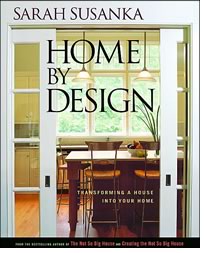 Home
by Design: Transforming Your House Into Home by Sarah Susanka,
AIA (Taunton Press, 2004)
Home
by Design: Transforming Your House Into Home by Sarah Susanka,
AIA (Taunton Press, 2004)
reviewed by Heather Livingston
Sarah Susanka’s Home by Design: Transforming Your House Into Home is the well known author/architect’s latest home improvement sensation. Conceiving the idea more than 10 years ago, Susanka has finally written the book she originally envisioned about the principles of design that led to the creation of The Not So Big House and the movement it inspired. Intended primarily for homeowners, but also useful to builders, architects, developers, realtors, and interior designers, Home by Design offers often simple solutions for design problems and gives laypeople the language necessary to discuss those elusive details that turn a house into home. True to her Not So Big roots, she reiterates that home size is less important than quality construction, a sense of order, use of light, and spatial interconnectivity.
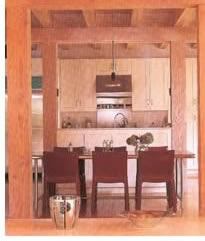 The book’s genesis
came from Susanka’s first home purchase. Knowing that limited funds
would require her to buy an as-built home, she made a list of desired
rooms, estimated overall space needed, and identified the neighborhood
of choice. Walking through the neighborhood one day, she passed a For
Sale by Owner sign on a little stucco house. Certainly not extraordinary
on the outside, it felt inviting when she walked up the path and knocked
on the art-glass adorned door. When the owner answered and Susanka peered
inside, she knew she had found her home. By day’s end, she had made
an offer.
The book’s genesis
came from Susanka’s first home purchase. Knowing that limited funds
would require her to buy an as-built home, she made a list of desired
rooms, estimated overall space needed, and identified the neighborhood
of choice. Walking through the neighborhood one day, she passed a For
Sale by Owner sign on a little stucco house. Certainly not extraordinary
on the outside, it felt inviting when she walked up the path and knocked
on the art-glass adorned door. When the owner answered and Susanka peered
inside, she knew she had found her home. By day’s end, she had made
an offer.
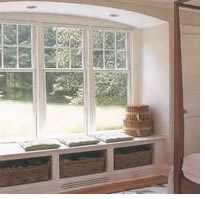 Not
the house she had envisioned for herself, Susanka wondered why she had
felt an instantaneous connection. What about the house made it appealing,
comfortable, and welcoming; what made it feel like home? She came to realize
that rooms and square footage were less important than she had believed,
and that the inherent details mattered considerably more than expected.
Out of this experience came Home by Design.
Not
the house she had envisioned for herself, Susanka wondered why she had
felt an instantaneous connection. What about the house made it appealing,
comfortable, and welcoming; what made it feel like home? She came to realize
that rooms and square footage were less important than she had believed,
and that the inherent details mattered considerably more than expected.
Out of this experience came Home by Design.
The architect’s toolbox
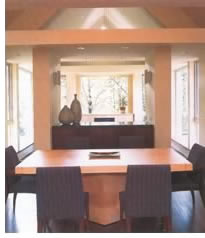 Although every house provides its occupants shelter, few actually enhance
quality of life. By providing what she calls the “architect’s
toolbox,” Susanka reveals to non-architects 27 building principles
that profoundly affect the way we perceive and function within a space.
The “toolbox” offers both concrete examples of design principles
and the language necessary to describe their sometimes elusive quality.
Featuring 30 stunning homes from Palo Alto, Calif., to Santa Fe to Minnetonka,
Minn., Home by Design is organized
into three broad sections—space, light, and order. Each chapter
within the sections addresses a particular building principle.
Although every house provides its occupants shelter, few actually enhance
quality of life. By providing what she calls the “architect’s
toolbox,” Susanka reveals to non-architects 27 building principles
that profoundly affect the way we perceive and function within a space.
The “toolbox” offers both concrete examples of design principles
and the language necessary to describe their sometimes elusive quality.
Featuring 30 stunning homes from Palo Alto, Calif., to Santa Fe to Minnetonka,
Minn., Home by Design is organized
into three broad sections—space, light, and order. Each chapter
within the sections addresses a particular building principle.
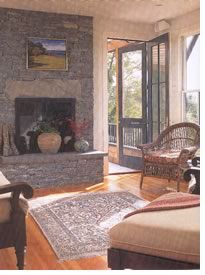 Space
Space
Susanka points out that non-architects tend to talk about space as related
to quantity—how much space is comfortable or necessary. Conversely,
architects use space as the primary tool in shaping how we experience
a structure. Although homebuyers typically can identify the type of house
they want—Georgian, Colonial, Bungalow, etc., they don’t have
a clear understanding of how the interior should look, feel, or operate.
They intrinsically know when a space doesn’t feel right, but can’t
define what makes a home work. This section reveals that the connectivity
among spaces is significant to the feel and function of a home. Including
chapters entitled The Process of Entering,
Sequence of Places, Ceiling Height Variety, and
Interior Views, it offers helpful information on characterizing
space through design concepts such as layering, implied walls, and ceiling
shape.
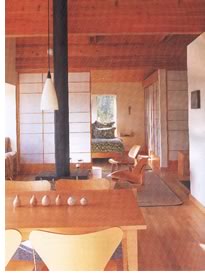 Light
Light
This section looks at ways light can be used to define a space. Anyone
who has experienced a truly inspiring structure can testify to the importance
of light, particularly natural light. Susanka notes that “Light
has the power to reveal the forms of things, to bring definition to their
textures and colors, and in doing so to give the spaces they inhabit a
particular ambiance.” With chapters focusing on Reflecting
Surfaces, View and Nonview, Visual Weight, and
Light Intensity Variation, Susanka illuminates important design
principles that enhance a home’s perceived warmth and comfort.
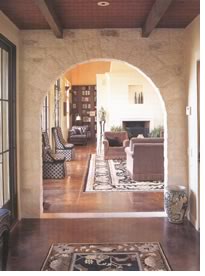 Order
Order
The third section, Order, reveals strategies for organizing a home’s
spatial arrangement. Susanka shows that without order, a house feels chaotic,
unintelligible; but when the elements of order are inherent in the design
of the space, we feel relaxed, comfortable, and safe. To illustrate her
points, Susanka details the use of Pattern
and Geometry, Alignments, Rhythm, Theme and Variations, and Composition.
She notes that “Most houses are lacking features like these that
tell you, as you move from room to room, that they are all parts of a
singular whole.” This section on Order highlights those elements
that unite the diverse components of a structure.
An easy-to-use and free-of-archispeak read, Home by Design offers thoughtful solutions for transforming house into home and provides much-needed tools to encourage a successful dialogue between homeowner and architect. Finally, homeowners are empowered with the understanding and language necessary to create the home of their dreams with their architects.
Copyright 2004 The American Institute of Architects.
All rights reserved. Home Page ![]()
![]()
 |
||
| Order this book from the AIA Store.
|
||